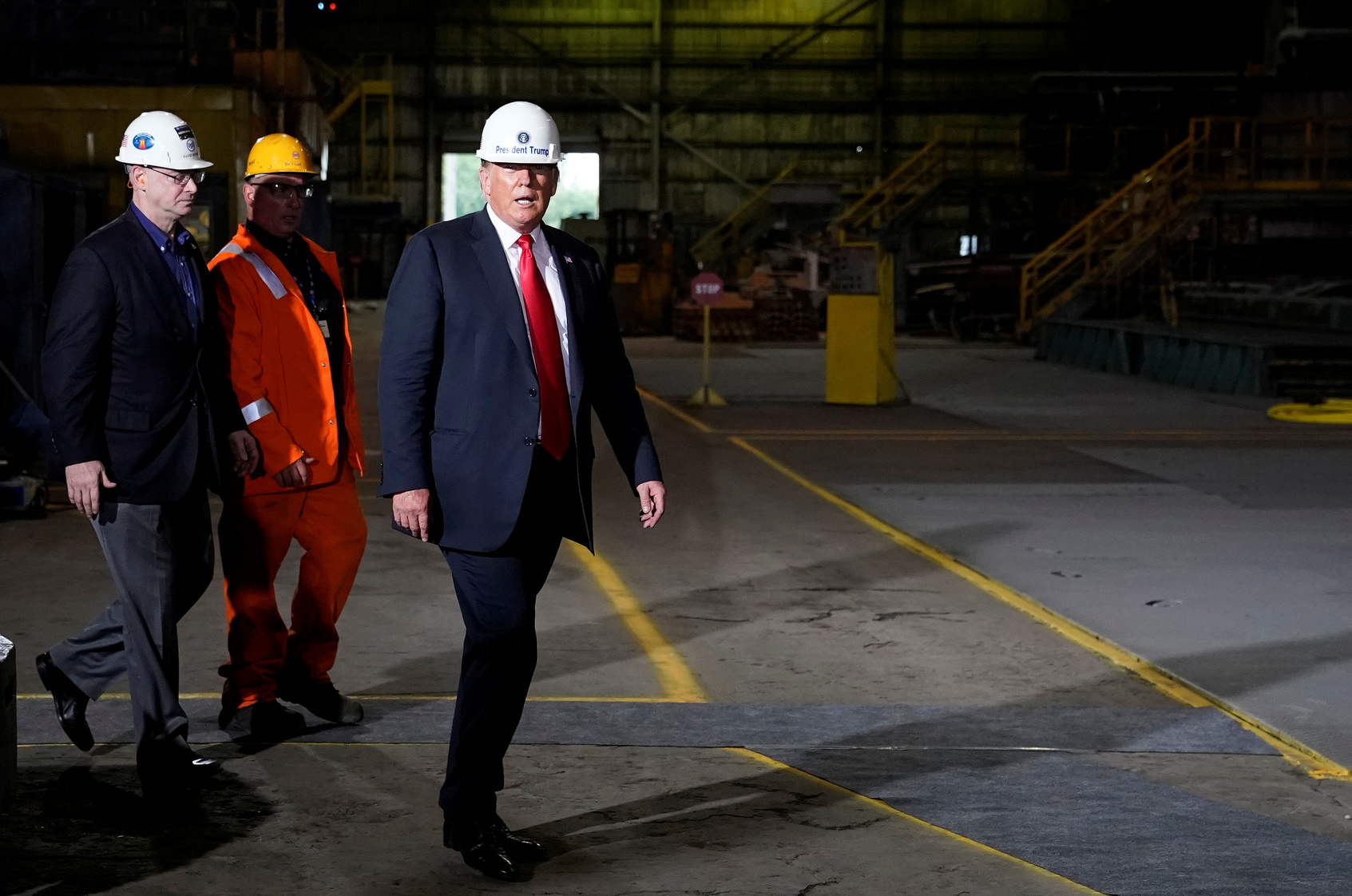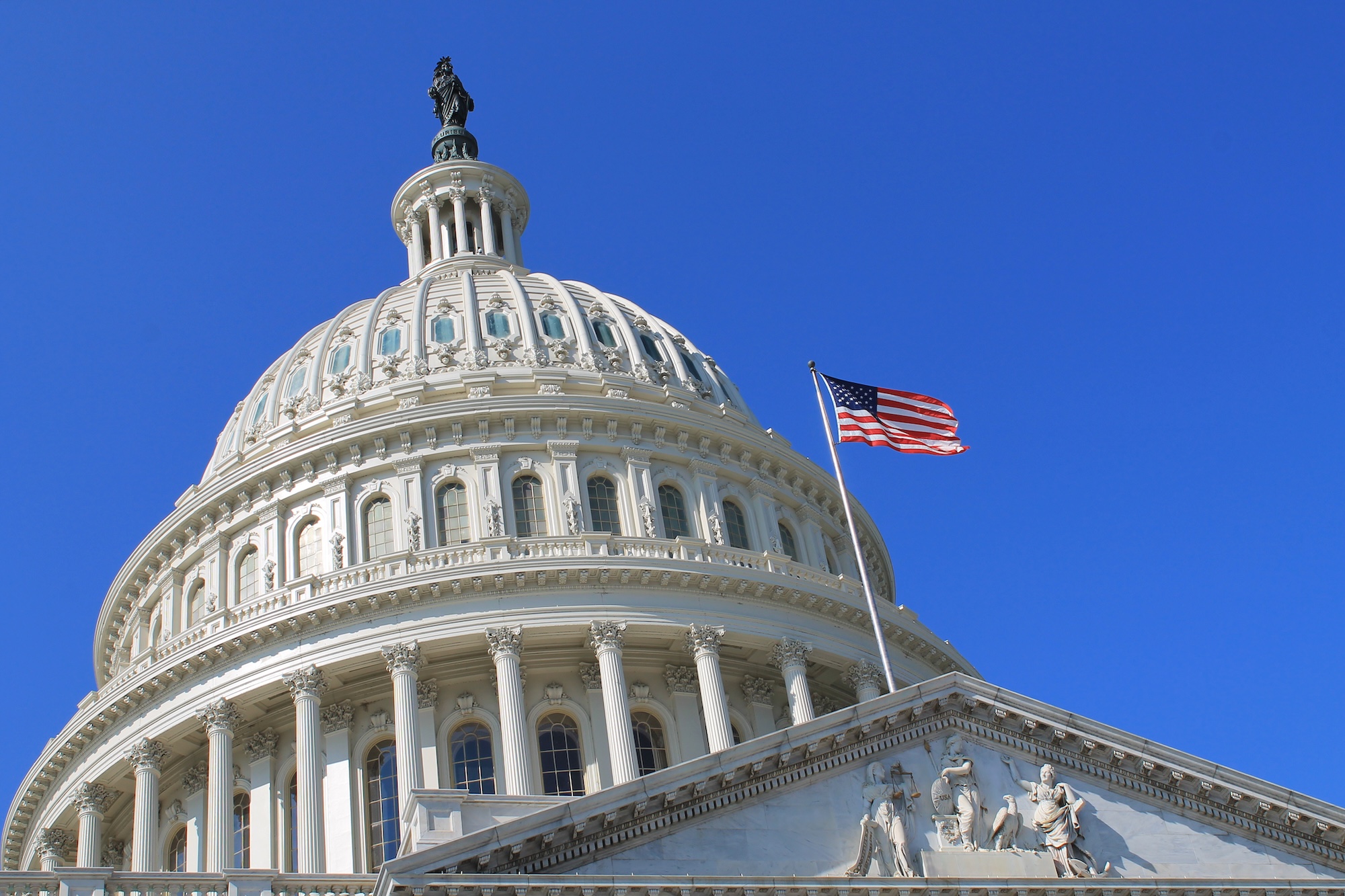

Trump's transitional presidency lacked the vision and agenda necessary to let go of GOP orthodoxy.
RECOMMENDED READING
Although Joe Biden advertised himself as a “transitional candidate” during the 2020 campaign, Donald Trump will probably be remembered as the transitional president. The issues his 2016 campaign raised, such as deindustrialization and competition with China, will continue to shape policy for the foreseeable future. Trump may also have paved the way for a different GOP than the one that has lost seven of eight presidential popular votes since 1988. But after one chaotic term, that future will be decidedly post-Trumpian rather than Trumpian.
The transitional character of the Trump administration is reflected in the missed opportunities that marked its economic policy record. The administration’s approach to issues ranging from taxes to trade to health care and beyond was often self-contradictory and incoherent. Throughout the Trump presidency, Republicans kept at least one foot firmly within the boundaries of conservative orthodoxy, even as parts of the administration and some in Congress began tentatively exploring the “populist” directions outlined in the 2016 campaign. Any attempt to evaluate Trump’s economic legacy must begin by separating these opposing strands. Doing so may also shed some light on the emerging debates over the post-Trump future in both parties.
The Failure of Trump’s Tax Cuts
The 2017 Tax Cuts and Jobs Act (TCJA), which significantly lowered corporate and personal tax rates, remains Trump’s signature legislative achievement. It was also, according to political scientists Jacob Hacker and Paul Pierson, the second-least popular piece of major legislation of the last twenty-five years. (The least popular was the 2017 attempt to repeal Obamacare.)
The reasons for this unpopularity are not difficult to grasp. The supply-side tax reform agenda that culminated in the TCJA has been standard GOP fare for decades, and its effect was never to raise wages or spur investment—however much those purported effects were used as justification—but to benefit holders of capital. The much-advertised Opportunity Zones, encouraging in principle as an effort to spur investment in struggling regions, have been beset by implementation struggles at the Treasury Department and thus far operate mainly as a capital-gains tax shelter.
Although, as Oren Cass notes in “Some Like It Hot,” it may be too soon to tell whether TCJA will contribute meaningfully to the nation’s prosperity, early analyses, such as one by the Congressional Research Service, indicate that it had little to no impact on either wages or business investment. But it did contribute to record corporate share buybacks—which mostly benefit the wealthiest stockholders. This should further discredit the Republican Party’s obsession with broad-based tax cuts as the primary lever of economic policy. Anyone campaigning for conventional tax relief in the future will likely have to explain why the biggest tax cuts since the Reagan administration had virtually no effect aside from inflating financial asset values. Republicans might also ask themselves why their party continues to pursue policies that disproportionately favor the wealthy when the most affluent parts of the country—including financial industry donors—preferred Democrats in 2020, despite the TCJA windfall.
“Even on the most sacrosanct issue of conservative dogma, some heterodoxies may slowly be seeping into the Republican consciousness.”
The exception that proves the rule was the expansion and increased refundability of the child tax credit, a policy that genuinely benefits the budgets of working- and middle-class families, and is opposed in supply-side temples like the Wall Street Journal’s editorial page as insufficiently “pro-growth” and no more beneficial than a “Canine Tax Credit.” The generous expansion was not part of the TCJA’s initial outline or a Trump administration priority, and the effort by Senators Marco Rubio and Mike Lee to include it, offset by a slightly smaller corporate-rate cut, was met with angry resistance within the GOP. The expansion was not as large as the headline numbers might suggest, however, because it was accompanied by the elimination of dependent exemptions.
By contrast, the tax increases imposed by the TCJA offer a generally positive legacy. The burden of its limitations on state and local tax (SALT) deductions primarily lands on the most affluent taxpayers in the most affluent locales, where the high cost of public services is otherwise subsidized by lower-tax jurisdictions. In addition, the TCJA imposed limits on the deductibility of corporate debt interest. In theory at least, this reduces the incentives for the high corporate debt burdens (often used to fund buybacks or cash returns to private equity owners) that have plagued the U.S. corporate sector in recent years. The TCJA also introduced a tax on large university endowments. While its effects to date seem minimal, the endowment tax is at least directionally correct in seeking to penalize unproductive concentrations of wealth, and it potentially opens the door to other forms of institutional “wealth taxes” in the future. Finally, the TCJA eliminated tax deferrals on 1031 exchanges not involving real property. The tax benefits for all of these transactions should perhaps be eliminated: there is no obvious reason for the federal government to subsidize real estate speculation.
These underappreciated measures within the TCJA may prove more durable and economically significant than the headline rate cuts in the long term. Even on the most sacrosanct issue of conservative dogma, some heterodoxies may slowly be seeping into the Republican consciousness.
Trade and Reshoring
A reflexive desire for tax cuts has been a staple of Republican platforms since Ronald Reagan, but Trump’s hawkishness on trade diverged from a decades-long bipartisan consensus. And despite resistance from the Republican establishment, the Trump administration arguably made more progress on trade policy than on any of the other populist themes aired during the 2016 campaign. From updating NAFTA to imposing tariffs on a wide range of goods to negotiating the “Phase One” deal with China, the Trump administration can point to a number of accomplishments. Moreover, Trump’s criticism of the trade policy of previous decades has become the new consensus position, as evidenced by the Biden campaign’s “Made in America” plan. Few people today view offshoring and deindustrialization as complacently as they did before Trump.
“Trump’s criticism of the trade policy of previous decades has become the new consensus position, as evidenced by the Biden campaign’s ‘Made in America’ plan. Few people today view offshoring and deindustrialization as complacently as they did before Trump.”
Nevertheless, the administration’s actual record on reshoring is little better than mixed. While Trump showed no lack of zeal in imposing tariffs, too often his administration failed to take the necessary steps beyond them to promote domestic investment, and Trump’s trade diplomacy was never integrated into a larger policy plan to promote strategic sectors. On trade overall, then, as in other policy areas, the Trump administration seems more likely to be remembered as the beginning of a larger transition than as the completion of a realignment.
Trump’s tariffs against China achieved tangible gains without resulting in anything like the catastrophes predicted by neoliberal “experts.” Consumer inflation and demand were not meaningfully affected, even in many targeted sectors. Moreover, the “trade war” eventually led to the signing of the Phase One deal with China, which commits the Chinese to an additional $200 billion in purchases of U.S. goods and services over 2017 levels and contains provisions addressing technology transfers, currency manipulation, and other contentious issues. Although China is already falling behind its purchase commitments, perhaps this is of secondary concern. The true purpose of the “trade war” was never to right the trade imbalance but to end America’s indifferent posture and bring the Chinese to the table about their abusive trade practices.
In fact, overall U.S. trade deficits continued to widen under Trump and, as a percentage of GDP, remained roughly where they were during most of the Obama administration. Perhaps most importantly, the U.S. trade deficits in advanced technology products and manufactured goods have widened significantly since 2016. Notably, the deficit with China did decrease substantially in 2019, but much of this appears to be the result of reshuffling supply chains to other countries (which may still constitute a victory in geopolitical terms) and not from reshoring back to the United States.
In theory, higher tariffs on imports plus lower corporate taxes at home should have produced a boom in capital spending and domestic production. In reality, however, investment remained anemic throughout the Trump presidency, especially when compared to similar periods of full employment, and a broad-based domestic manufacturing rebound never materialized.
Why not? In my view, Trump’s tariff–tax cut combination failed to boost domestic production primarily because tariffs are far more effective at protecting existing industries than at developing new (or lost) ones. The depleted U.S. industrial base is more in need of the latter. Thus while tariffs likely did encourage some additional investment in the steel sector, for example, they were unlikely to encourage the rebuilding of hollowed-out sectors such as telecom equipment manufacturing, flat-panel displays, lithium-ion batteries, heavy forgings, advanced machine tools, laser diodes, drone hardware, active pharmaceutical ingredients, and on and on.
Developing advanced manufacturing industries—and, specifically, competing with the Asian manufacturing model—requires a much more robust set of supporting policies aside from trade barriers, such as investment subsidies, supply chain mapping, shared production facilities, process innovation support, and sources of stable demand (e.g., government procurement). The Trump administration was too often absent on all of these issues. Indeed, the administration on multiple occasions proposed cutting funding for the few programs that undertake such activities, such as the Manufacturing Extension Partnership and Manufacturing USA institutes, as well as various agencies tasked with export promotion, technological research, infrastructure development, and other critical programs. The administration did arrange a subsidized deal with Taiwan Semiconductor to build a new semiconductor foundry in Arizona and supported a few other manufacturing projects. But nowhere did its efforts coalesce into a coordinated industrial strategy.
Labor and Immigration
Few things about the Trump administration are uncontroversial, but relatively robust income growth during his presidency, particularly among lower-earning cohorts, should be widely celebrated. Although overall inequality as measured by the Gini coefficient continued to rise while Trump was in office—primarily driven by a buoyant stock market—lowest-quartile wages grew faster than those of higher-earning workers. In 2019, bottom quartile wages grew at 4.7 percent. Unemployment, which was 4.7 percent when Trump took office, reached a fifty-year low of 3.5 percent in September 2019.
Of course, the extent to which the Trump administration’s policies actually drove this growth is a more debatable question. Rising minimum wages, for example, certainly had something to do with it: twenty-three states increased their minimum wages in 2019 alone, and bottom-quartile wages grew significantly faster in those states. The Trump administration can hardly take credit for these developments, even if Trump personally was less hostile to minimum wage increases than conventional pre-Trump Republicans, despite his opposition to a $15 federal minimum in 2020.
Indeed, for all the talk of Trump as a tribune of the working class—including from the president himself—his administration never really strayed from Republican orthodoxy on conventional labor issues. Trump’s NLRB acted to make unionization more difficult on multiple occasions, while the Department of Labor took steps to reduce the number of workers eligible for overtime pay. Recently, DOL has proposed broadening the classification criteria for independent contractors, making it easier for “gig economy” firms to exclude workers from employee benefits. To be sure, no one expected the Trump administration to launch experiments with sectoral bargaining or other ambitious labor policies, but if the GOP genuinely wants to claim the mantle of the “working-class party,” it will need to update its playbook on these issues.
“For all the talk of Trump as a tribune of the working class—including from the president himself—his administration never really strayed from Republican orthodoxy on conventional labor issues.”
A stronger case can be made for the administration’s immigration restrictions, especially with respect to the labor market’s lower end. As The Economist reported earlier this year, wages in occupations with a high percentage of low-skill immigrant labor (such as housekeepers and some maintenance workers) saw faster wage growth than other low-paid jobs. Geographies that experienced declines in their foreign-born populations also outperformed in wage growth.
Yet even on immigration, the Trump administration’s policy was less consistent and less aggressive than was typically portrayed in the media, and many proposed changes were blocked by the courts. While the nation’s foreign-born population had grown by roughly 650,000 per year since 2010, the rate fell by more than two-thirds in 2017, averaging 203,000 from 2017 to 2019. Yet attribution to specific policy changes is a challenge. Trump was only able to implement a few policy changes during the first three years of his presidency, mostly concerning refugees and asylum admissions (though approvals of asylum applications increased during Trump’s term, and deportations were notoriously lower than they were under President Obama). The most significant restrictions—such as suspending the issuance of new H-1B visas—were not imposed until after the COVID-19 outbreak in 2020.
From 2016 to 2019, H-2A (seasonal agricultural workers) visa issuances actually rose considerably, while H-2B (seasonal non-agricultural workers) visas increased slightly in 2019. In the same period, before COVID-19, H-1B issuances were roughly flat.
Of course, popular perception itself affects migration flows. But a change in tone is not the same as consistent enforcement—especially with respect to employer violations—or substantive reform. Unfortunately, immigration largely remains a symbol in America’s culture wars—and Trump’s own rhetoric only further polarized the issue—while its economic ramifications, which could perhaps unite a broader legislative constituency, are too often ignored.
Financial Regulation and Monetary Policy
Trump’s approach to the financial industry during his first campaign was often conflicted—featuring both harsh attacks on fund managers and promises to “dismantle” Dodd-Frank. But his administration was consistently soft on the industry, though not especially ambitious in any direction. In 2018, for example, the president signed a bipartisan bill that raised the threshold at which enhanced regulations for “systemically important financial institutions” would go into effect, but broadly left Dodd-Frank’s provisions intact.
The president’s approach to monetary policy was far more visible. Trump consistently and vociferously called for more accommodative monetary policy throughout his tenure—which his appointed Fed chair, Jay Powell, largely delivered—in contrast to traditional conservative rhetoric that emphasizes inflation fears and “sound money.” While low rates are not without problems, it seems highly unlikely that any of the Trump era’s economic successes would have been possible without them. Moreover, congressional Republicans’ willingness to generally fall in line behind Trump on this question perhaps signals that the discredited notion of monetarism is finally losing its grip on the party’s collective consciousness.
On the other hand, in 2020, Trump nominated Judy Shelton—an advocate of the gold standard with hawkish views on both monetary policy (at least prior to Trump’s election) and fiscal deficits—to the Federal Reserve’s Board of Governors. Although she failed to receive Senate confirmation, Shelton’s nomination once again revealed the inability of the administration and the Republican Party to pursue a clear direction on key policy questions.
Big Tech and Antitrust
In one of the few points of agreement during the 2020 presidential campaign, both Trump and Biden called for repealing Section 230, a provision of the Communications Decency Act that grants liability protections to social media and other internet platform providers—and which often functions as a signifier of broader efforts to rein in Big Tech. In general, skepticism of the tech companies has increased across the political spectrum since Trump entered office. The administration’s actual policy record on these issues, however, is more complicated.
For example, Trump signed the Stop Enabling Sex Traffickers Act in 2018, which curbed 230 protections on content that violates sex trafficking laws. In 2020, Trump’s FCC also indicated that it would begin exercising its authority to “interpret” Section 230, though the significance of any potential FCC intervention is still unclear. Finally, in December 2020, Trump threatened to veto the National Defense Authorization Act if Section 230 was not repealed; as of this writing, it is unclear whether this threat will produce any results with only a few weeks remaining in Trump’s presidency.
“In truth, after four years, most of the administration’s tough talk has amounted to little more than—ironically—tweets.”
Meanwhile, Trump’s FTC and Justice Department have announced antitrust investigations into Amazon, Facebook, Google, and other tech behemoths, with the Justice Department filing suit against Google in October 2020. The implications of these antitrust actions could ultimately be immense, but to date no concrete rulings or penalties against the tech companies have been enforced.
In truth, after four years, most of the administration’s tough talk has amounted to little more than—ironically—tweets. Today, the Big Tech firms are larger and stronger than ever, especially in the wake of COVID-19’s devastation of many small businesses. Even on the question of censorship—the issue of greatest concern to most Republican politicians—the power of the social media platforms has increased dramatically since Trump was elected, to the point of censoring the president’s own social media accounts with impunity. Indeed, the Trump administration continually catered to Big Tech’s interests, aggressively defending the industry’s tax arbitrage strategies against international efforts to tax digital commerce. Trump also went out of his way to denounce European antitrust action against tech monopolies. As long as this is the case, it will be difficult to view Republican criticism of Big Tech—which has proven remarkably malleable—as anything more than theatre.
A Mixed Record
Donald Trump will leave office with a decidedly mixed record—not only with the typical wins and losses of any presidency, but also in terms of the administration’s crosscutting ideological tendencies. The GOP will have to resolve these tensions at some point—while the Biden administration is about to face many of the same questions in its own way—and the right direction should be obvious: Trump’s conventional conservative economic policies (e.g., tax cuts, Obamacare repeal) were unpopular failures; his more “populist” overtures—while certainly leaving room for improvement—fared better. Many of those policies achieved broad, cross-partisan appeal and could, in the long run, prove to be enduring successes.
If the polarization and sensationalism around Trump’s persona fade with time, his policy record will probably be found to compare reasonably well against those of the other post–Cold War presidents. At the very least, even accounting for a shaky response to COVID-19, Trump avoided the multiple catastrophes of the George W. Bush administration.
But his successors will have to do better than that if we are to overcome the significant and growing challenges facing America at this time. Trump’s “transitional” presidency will only be a success if it ushers in administrations who can more coherently and competently pursue the most promising themes of the populist project.
Recommended Reading
Republican Party Battles Over its Post-Trumpian Soul
American Compass’s Oren Cass spotlights the ideological contest between libertarian Republicans and post-Trump conservatives for the future identity of the American political right.
Oren Cass Urges Conservatives to Shed Free-Market ‘Orthodoxy’
Peter Coy highlights American Compass executive director Oren Cass’s piece in Foreign Affairs on the path forward for post-Trump conservatism.
From the Primordial Supply-Side Soup
This morning’s commentary from the Wall Street Journal editorial board is of great scientific import, a fragile creature crushed into a perfectly preserved fossil by the forces of reality. Future researchers tracing the evolution of the American right-of-center from market fundamentalism to a viable economic conservatism will regard it as a vital transitional form—like a fish with legs but no lungs: laughably incoherent, woefully unsuited to its environment, and yet also an unmistakable sign of progress and a harbinger of better things to come.











